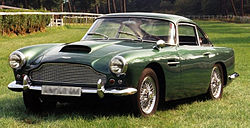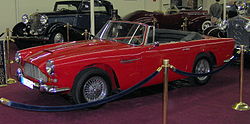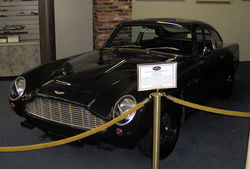- Aston Martin DB4
-
Aston Martin DB4  1960 Aston Martin DB4 (Series 2)
1960 Aston Martin DB4 (Series 2)Manufacturer Aston Martin Production 1958–1963
1,210 produced[1]
1,110 DB4
100 DB4GT/ZagatoPredecessor Aston Martin DB Mark III Successor Aston Martin DB5 Class Sports car Body style 2+2 coupé
2-seat coupé
2+2 dropheadLayout FR layout Engine 3.7 L Tadek Marek 240hp I6[2] Wheelbase 98 in (2,489 mm)[3] Length 177 in (4,496 mm)[3] Width 66 in (1,676 mm)[3] Height 52.5 in (1,334 mm)[3] Curb weight 2734 pounds [4] Related DB4 GT Zagato
Lagonda RapideThe DB4 is a sports car sold by Aston Martin from 1958 until 1963. It was an entirely different car from the DB Mark III it replaced, though the 3.7 L engine was externally visually related to the 2.9 L unit found in that car. The DB4's unique design and performance would later form the basis for future Aston Martin classics, such as the DB4 GT Zagato, the Lagonda Rapide 4-door saloon, and its ultimate replacement the Aston Martin DB5.
Contents
Design
The lightweight superleggera (tube-frame) body was designed by Carrozzeria Touring in Milan, and its Continental looks caused a sensation on its unveiling at the 1958 London Motor Show. Although the design and construction techniques were Italian, the DB4 was the first Aston to be built at the company's Newport Pagnell works in Buckinghamshire, England.
Specifications
The 3.7 L (3670 cc/223 in³) engine, designed by Tadek Marek, was a dual overhead cam straight-6, with cylinder head and block of cast R.R.50 aluminium alloy. The engine was prone to overheating initially, but the 240 hp (179 kW)[3] produced by the twin-SU carburettor version made buyers forgive this unfortunate trait. Servo assisted Disc brakes were fitted all around, with early 11.5 in (292 mm) Dunlops being replaced by Girlings. The independent front suspension used ball-jointed wishbones and coil springs and the live rear axle[2] also using coils springs with location by a Watt's linkage. Rack and pinion steering was used. There was a choice of final drive ratios, the normal one for British and European use was 3.54:1, the United States usually got a 3.77:1 and a 3.31:1 was also available for customers wanting a car with an especially high top speed.
Performance
A car with the British standard 3.54 final drive ratio tested by The Motor magazine in 1960 had a top speed of 139.3 mph (224.2 km/h) and could accelerate from 0-60 mph (97 km/h) in 9.3 seconds. A fuel consumption of 17.7 miles per imperial gallon (16.0 L/100 km; 14.7 mpg-US) was recorded. The test car cost £3967 including taxes.[3]
Models
"Series" DB4s
There were five "series" of DB4s, with the most visible changes being the addition of window frames in Series II and the adoption of a barred (rather than eggcrate) grille in Series IV. The Series V cars of September 1962 have a taller and longer body to provide more interior space, though the diameter of the wheels was reduced to keep the overall height the same. The front of the Series V was updated with a more aerodynamic look that was later carried over to the DB5 cars.
DB4 Convertible
A convertible was introduced in 1962. It featured in-house styling similar to the Touring saloon, and an extremely rare factory hardtop was also available. In total, 70 DB4 convertibles were made from a total DB4 production run of 1110 cars.[5] Top speed was about 136mph.[6]
DB4 GT
See also: Aston Martin DB4 GT ZagatoThe DB4 GT was a special lightweight, high-performance version of the DB4. Introduced in September, 1959, the GT's featured enclosed headlights and a thinner aluminium skin for lighter weight. The wheelbase was also reduced in comparison to the standard car, which resulted in many cars not being fitted with rear seats.
The engine, though, was what made the GT special. Available in 3.7 L (3670 cc/223 in³) and 3.8 L (3750 cc/228 in³) versions, the GT's engine had twin sparkplugs per cylinder with two distributors and three twin-choke Weber carburettors. Modifications to the cylinder head brought compression to 9.0:1 and power output was 302 hp (225 kW). Maximum speed for the GT was 151 mph (246 km/h)[4] with a 6.1 second sprint to 60 mph (97 km/h).
Seventy-five GTs were built with this body style. Nineteen more were modified by the Zagato works in Italy into DB4 GT Zagatos, with plain oval grilles, sans the stock GT's tail fins, and a smoothed out rear end. A single car was also styled by Bertone and dubbed the Bertone Jet.
Vantage
With the introduction of the Series IV in 1961, a high-performance DB4 Vantage was also offered. It featured three SU carbs and special cylinder heads, increasing power to 266 hp (198 kW). Most Vantage models also used the enclosed headlights of the DB4 GT as well. In all, there were 136 saloons and 32 convertibles with the Vantage engine.
Vantage GT
A tiny number of non-GT DB4s used the GT's more-powerful engine. This combination is often called a Vantage GT, though not all included the Vantage package and none was technically a GT. Three Series III, five Series IV, and six Series V cars have this unusual combination of body and engine for a total of 14.
References
- ^ Edwards, Robert (2004). Aston Martin. Sparkford: Haynes Publishing. pp. 45, 67. ISBN 1-84425-014-8.
- ^ a b Willson, Quentin (1995). The Ultimate Classic Car Book. DK Publishing, Inc.. ISBN 0-7894-0159-2.
- ^ a b c d e f "The Aston Martin DB4 Saloon". The Motor. 14 September 1960.
- ^ a b "1959 Aston Martin DB4 GT performance, specs, data & photo". Automobile-catalog.com. http://www.automobile-catalog.com/make/aston_martin/db4/db4_gt/1959.html. Retrieved 2011-11-09.
- ^ Edwards, Robert (2004). Aston Martin. Sparkford: Haynes Publishing. p. 53. ISBN 1-84425-014-8.
- ^ "1961 Aston Martin DB4 Convertible performance, specs, data & photo". Automobile-catalog.com. http://www.automobile-catalog.com/make/aston_martin/db4/db4_convertible/1961.html. Retrieved 2011-11-09.
- 1. Mark Ewing (September 1990). "One Fine Lorry". Sports Car International 6.9: 28–30.
- 2. "Newport Pagnell 6 Cylinder Cars". AstonMartins.com. http://www.astonmartins.com/db4_5_6_s/index.html. Retrieved 23 June 2005.
External links
- Aston Restoration Website – A site devoted to information on restoring an Aston Martin, including DB4
- Original Aston Martin brochures – Original sales literature for Aston Martin viewable online, including the DB4
Aston Martin and Lagonda road car timeline, 1948–present Type 1940s 1950s 1960s 1970s 1980s 1990s 2000s 2010s 8 9 0 1 2 3 4 5 6 7 8 9 0 1 2 3 4 5 6 7 8 9 0 1 2 3 4 5 6 7 8 9 0 1 2 3 4 5 6 7 8 9 0 1 2 3 4 5 6 7 8 9 0 1 2 3 4 5 6 7 8 9 0 1 Owner David Brown Limited William Wilson Sprague & Minden Pace Petroleum & Gauntlett Gauntlett & Livanos Gauntlett, Livanos & Ford Ford Richards, Sinders, Dar, Adeem City car Cygnet Zagato / Limited Run
DB4 GT Zagato V8 Zagato DB7 Vantage Zagato V12 Zagato DB AR1 One-77 Super Grand tourer SWB V8 Vantage Virage Vantage V8 Vantage V12 Vanquish DBS V12 Grand tourer V8 Virage V8 Virage DB4 DB5 DB6 DB7 DB9 DB1 DB2 DB2/4 DB Mk III DBS Vantage V8 Vantage / Luxury saloon 2.6-Litre 3-Litre Rapide Lagonda Rapide Categories:- Aston Martin vehicles
- 1950s automobiles
- 1960s automobiles
- Vehicles introduced in 1958
- 24 Hours of Le Mans race cars
Wikimedia Foundation. 2010.


